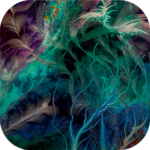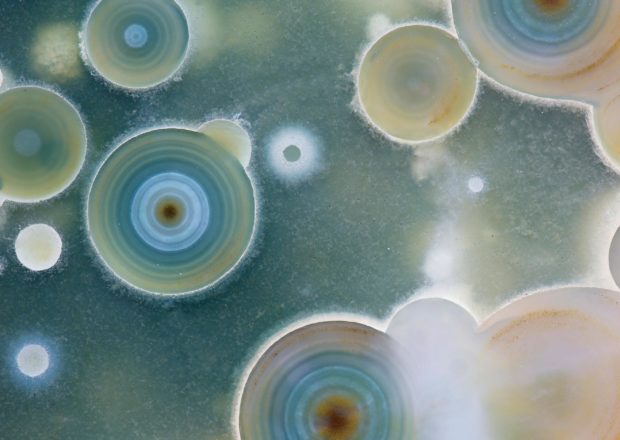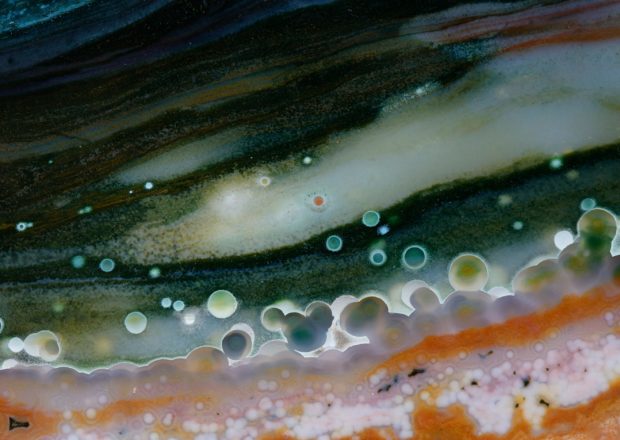The Art
The Animations
About the Photos, Animations and Music
Q: The photos of orbs, the animations, the accompanying music— Your media palette is evolving.
RS: With this, as with so many things, I remain a follower of William Blake. For me, he defined a new kind of art, where the idea was central and everything else—story, characters, words and visuals—serve the idea. We know now that he wrote music for a number of his poems.
Q: The Dissolve photographs, from which the animations were created, are of real, arrestingly beautiful rocks. Tell us about them.
RS: The Dissolve orb rock is a species of chalcedony commonly known as “ocean jasper.” While occasional samples surfaced during the latter part of the twentieth century, the first deposit was discovered in northwest Madagascar on a remote beach after a concerted search by gem hunter, Paul Obenich.
The rock was introduced to the gem world in 2000. Subsequently, a handful of small veins were discovered and mined between 2000 and 2013, all in close proximity to the original find. The material in those veins has been mined out, and there have been no new discoveries to date. Ocean jasper is made up of quartz crystals with a structure so fine that the crystals are invisible to the naked eye.
I collected samples of ocean jasper from 2013 to 2015, and they helped inspire the Dissolve project. Slabs were cut and mirror-polished by a variety of sources, including Obenich, the current mine owner, and Robert Cropp.
Q: And those stunning photographs?
RS: The slabs were photographed at magnifications ranging from 1X to 5X by Cameron Nelson. Slabs were placed on a copy stand with a black posterboard background in a room with a skylight. All photos were taken using only that natural light source. No filters or additional lighting were used.
Q: The animations seem to take you inside the rock, and through the visionary landscapes of the orbs’ realm.
RS: Credit the animators for that. The still photos, as they were taken, appear as the closing images for each animation. We did the storyboarding, then had the animators bring them to life.
Q: Much of the accompanying music was written by the late, great Lhasa de Sela.
RS: She was one of a kind. Those of us who were touched by her magic miss her badly. I helped out with the first and last pieces, and the piece for Chapter 3.
Q: I was touched by the lullaby at the end. The song seems like a bridge between being and not being. An infant’s version of what Wiley goes through.
RS: Mister Moon was a collaborator on this project. He drives so much of what happens. He was in the heavens the night my first child was born. The experience of birth shook me deeply, as it does many first-time parents. My wife and newborn had to stay in the hospital for another day, so I returned home alone. There was no possibility of sleep. I picked up an instrument, and the lullaby poured out of me. The recording included with the project is the recording I made that night.
Animation and Music Credits
All animations created from photographs by Cameron Nelson.
Produced by Rich Shapero, Jan Lindsay-Smith and Josh Turner.
Revelation:
Animation: Tavet Gillson and Janelle Miau
Music: written by Rich Shapero, produced by Josh Turner
Musicians: John R. Burr (piano), Nils Petter Molvær (trumpet)
Imagination:
Animation: Tomas Cottle
Music: “Para el Fin del Mundo o el Año Nuevo” written by Lhasa de Sela, produced by Jean Massicote and François Lalonde
Musicians: Jean Massicote (Rhodes, synth), François Lalonde (percussion) and Nils Petter Molvær (trumpet)
Exploration:
Animation: Tavet Gillson
Music: “La Marée Haute” written by Lhasa de Sela, produced by Jean Massicote and François Lalonde
Musicians: Jean Massicote (piano), François Lalonde (percussion, glockenspiel), Jean-Denis Levasseur (clarinet, bass clarinet) and Nils Petter Molvær (trumpet)
Actualization:
Animation: Tomas Cottle
Music: written by Rich Shapero, produced by Josh Turner
Musicians: Rich Shapero (guitar) and Nils Petter Molvær (trumpet)
Excavation:
Animation: Andres Fouché
Music: “Anywhere on This Road” written by Lhasa de Sela, produced by Jean Massicote and François Lalonde
Musicians: François Lalonde (percussion, bass), Olivier Langevin (guitar), Ibrahim Malouf (trumpet) and Nils Petter Molvær (lead trumpet)
Atomization:
Animation: Tomas Cottle
Music: “Pa’ Llegar a Tu Lado” written by Lhasa de Sela, produced by Jean Massicote and François Lalonde
Musicians: Jean Massicote (piano), Nils Petter Molvær (trumpet)
Peregrination:
Animation: Andres Fouché
Music: “My Name” written by Lhasa de Sela, Jérôme Lapierre and Vincent Ségal, produced by Jean Massicote and François Lalonde
Musicians: Jean Massicote (Rhodes, organ), François Lalonde (percussion, glockenspiel) and Nils Petter Molvær (trumpet)
Encapsulation:
Animation: Tomas Cottle
Music: “I’m Going In” written by Lhasa de Sela, produced by Jean Massicote and François Lalonde
Musicians: Jean Massicote (piano), Nils Petter Molvær (trumpet)
Navigation:
Animation: Andres Fouché
Music: “Soon This Space Will Be Too Small” written by Lhasa de Sela, produced by Jean Massicote and François Lalonde
Musicians: Jean Massicote (piano), François Lalonde (percussion, glockenspiel) and Nils Petter Molvær (trumpet)
Declination:
Animation: Tomas Cottle
Music: “Small Song” written by Lhasa de Sela, produced by Jean Massicote and François Lalonde
Musicians: Jean Massicote (Rhodes), François Lalonde (percussion), Jean-Denis Levasseur (ukulele), and Nils Petter Molvær (trumpet)
Reconception:
Animation: Tomas Cottle
Music: written by Rich Shapero, produced by Josh Turner
Musicians: Maria Taylor (vocals), John R. Burr (piano)
Mister Moon (Bonus Track):
Music: written by Rich Shapero, produced by Rich Shapero
Musicians: Rich Shapero (vocals and mandolin)
































